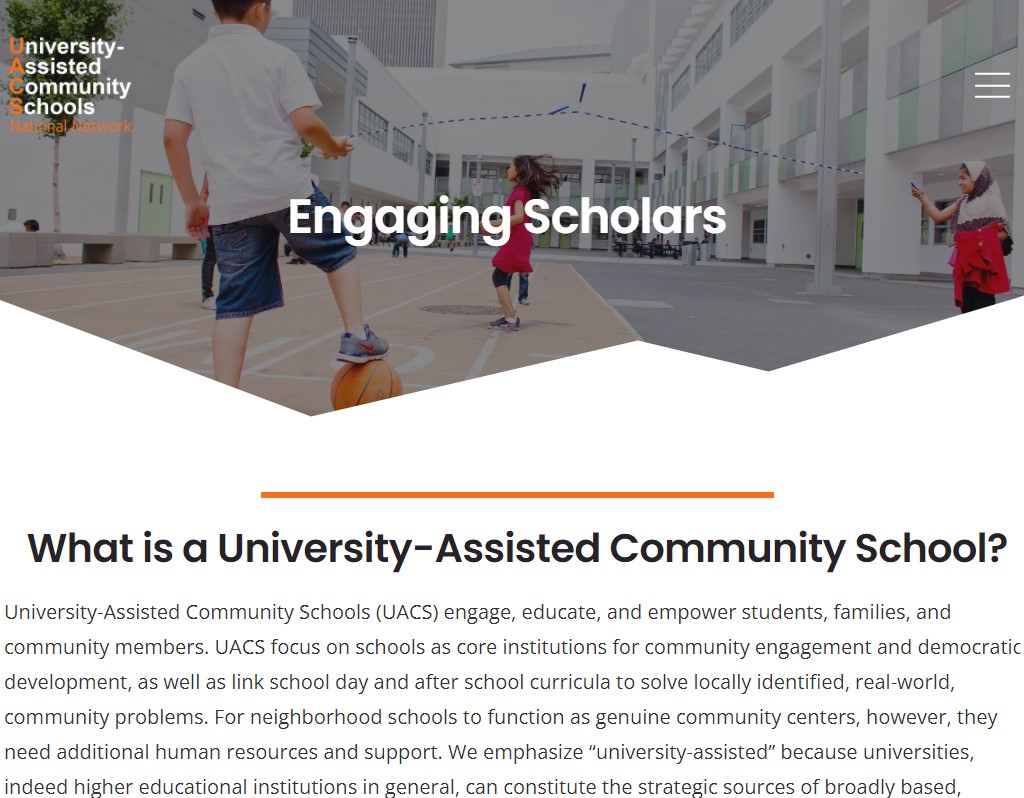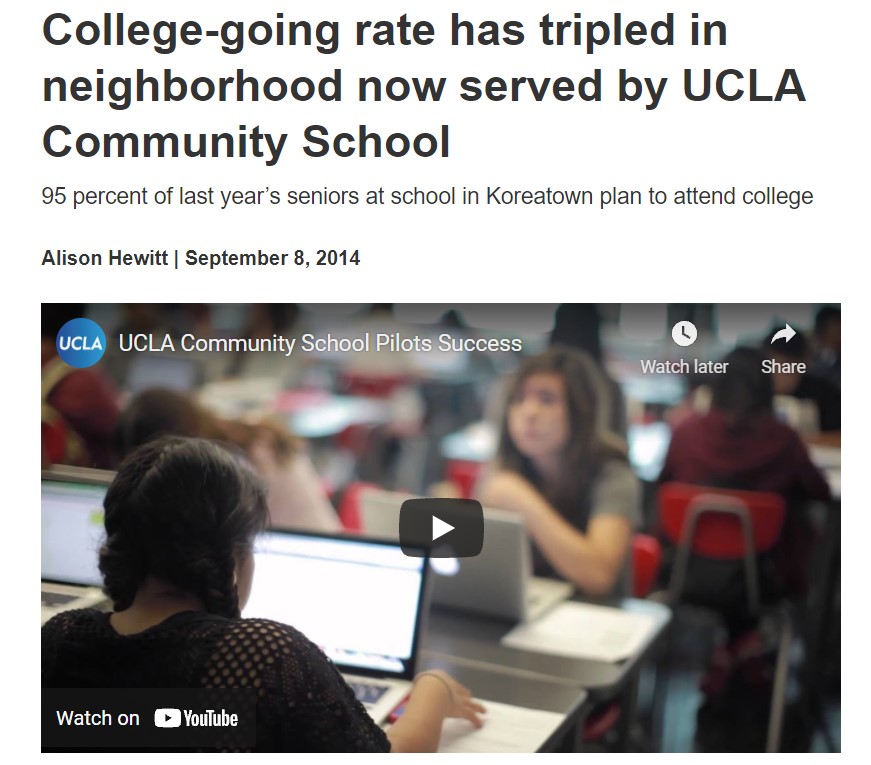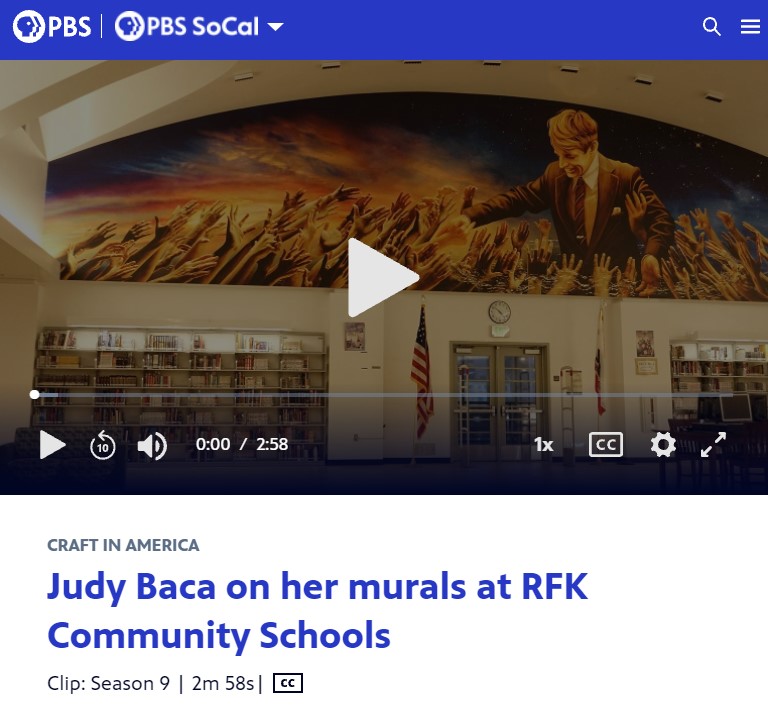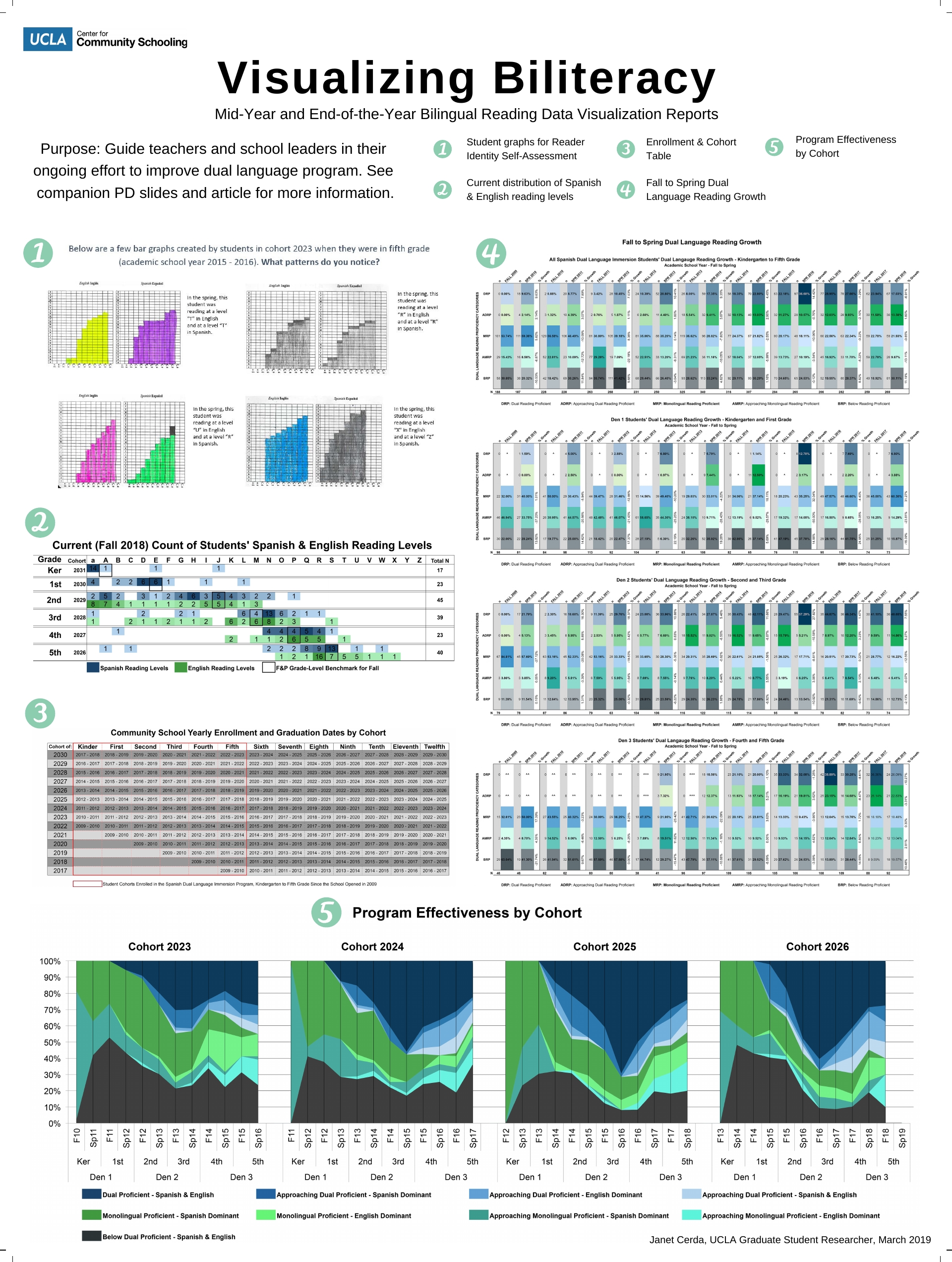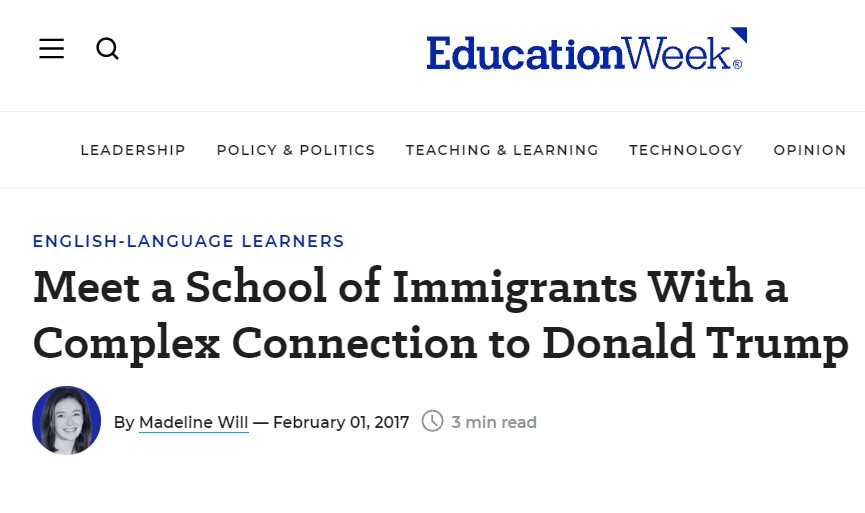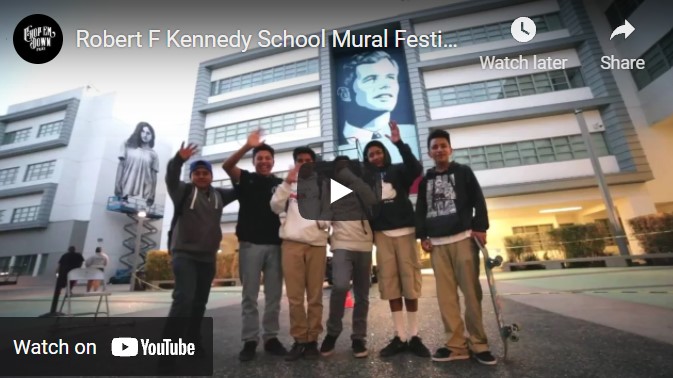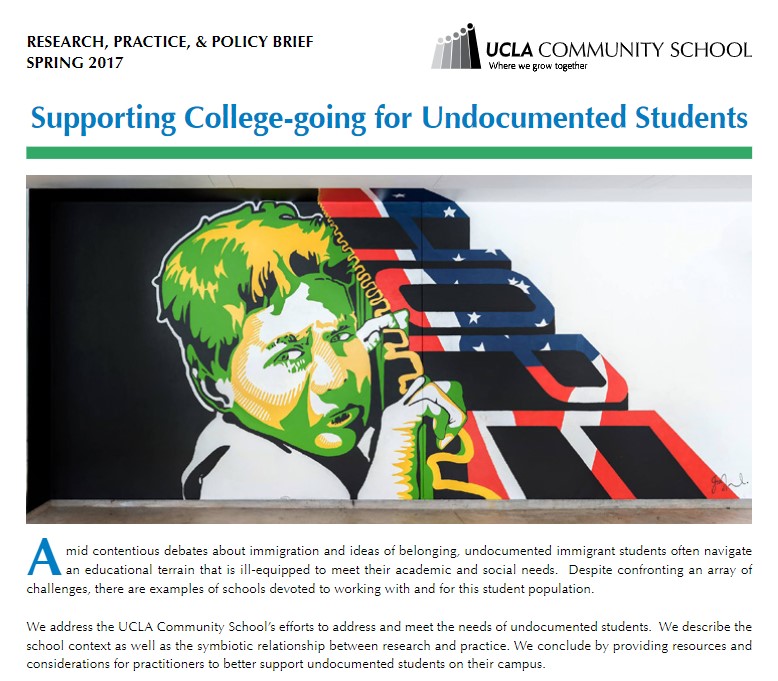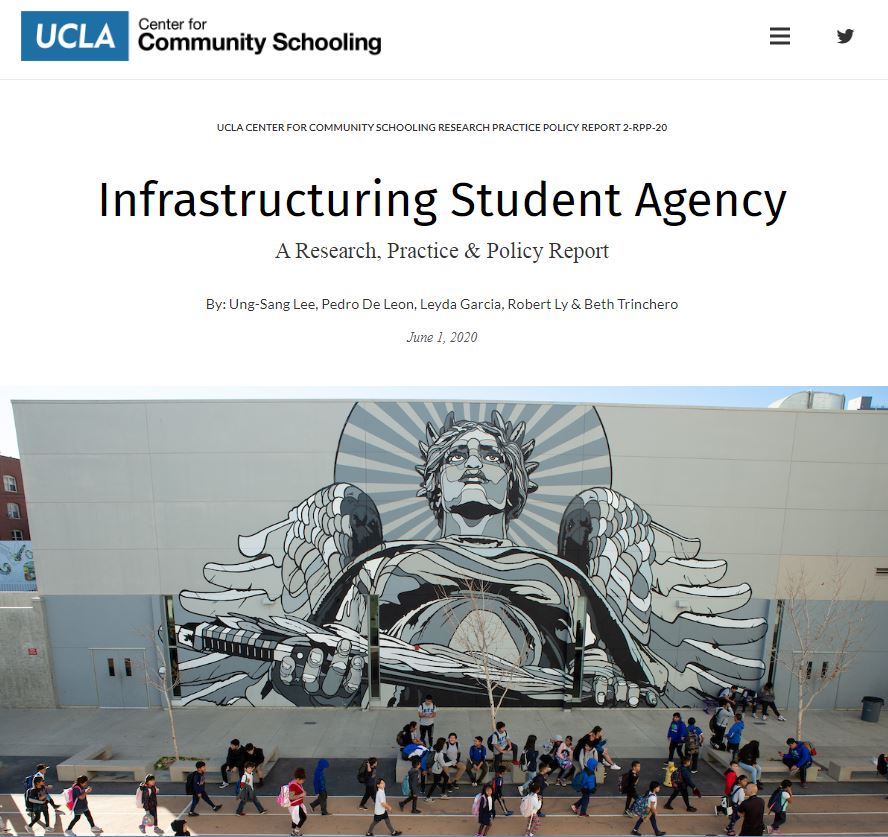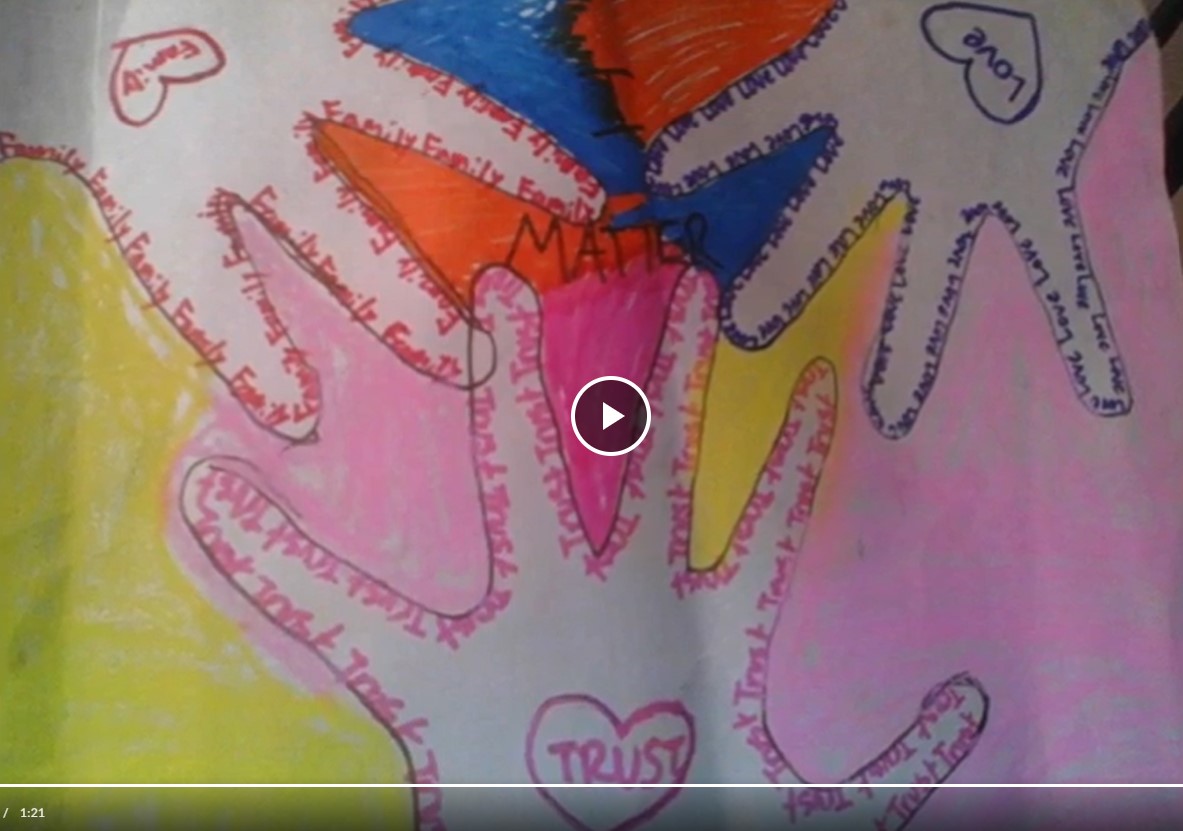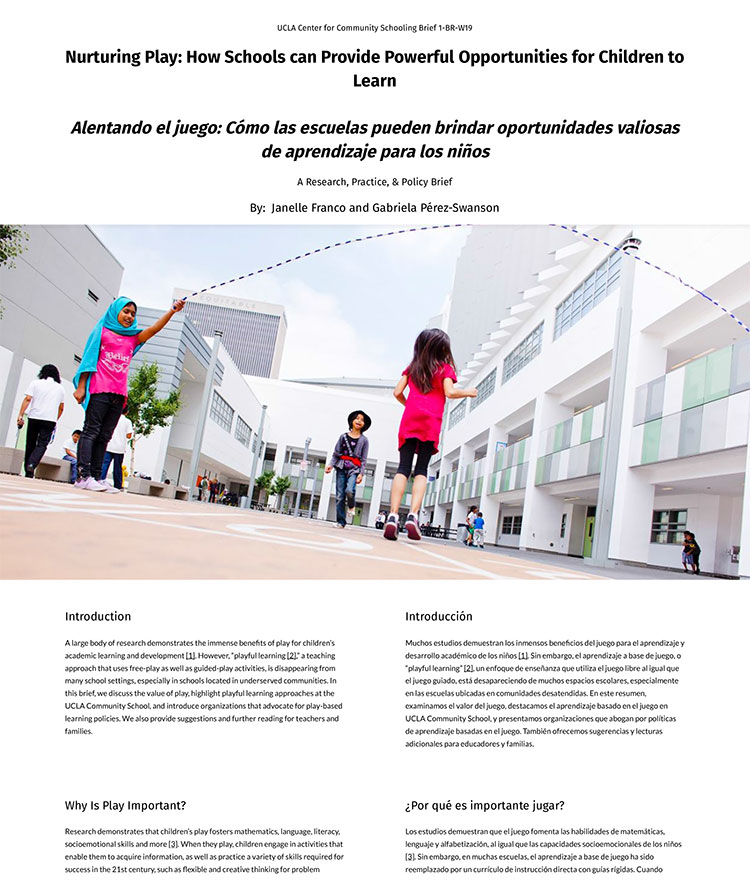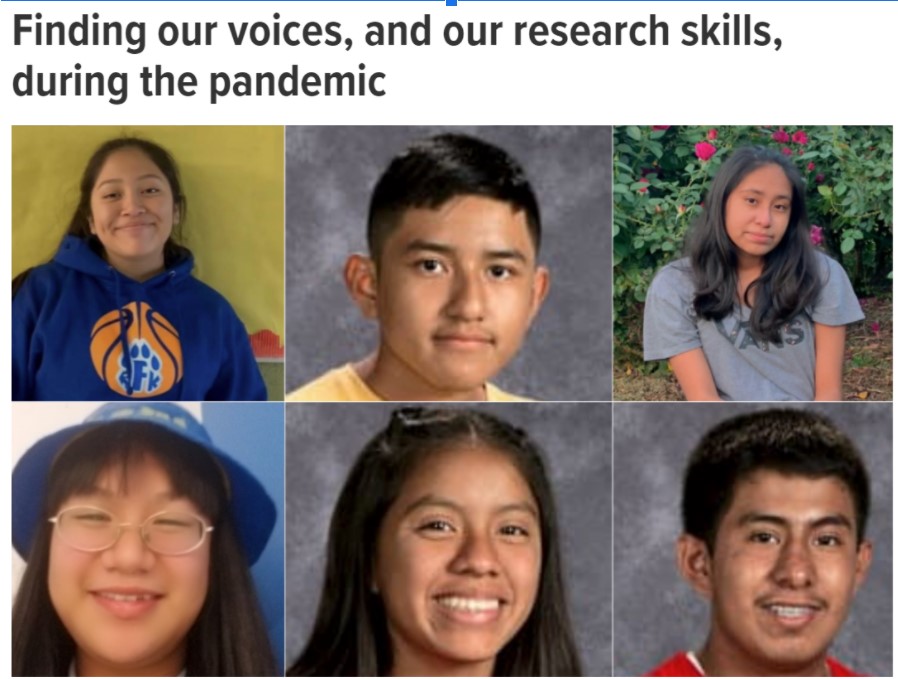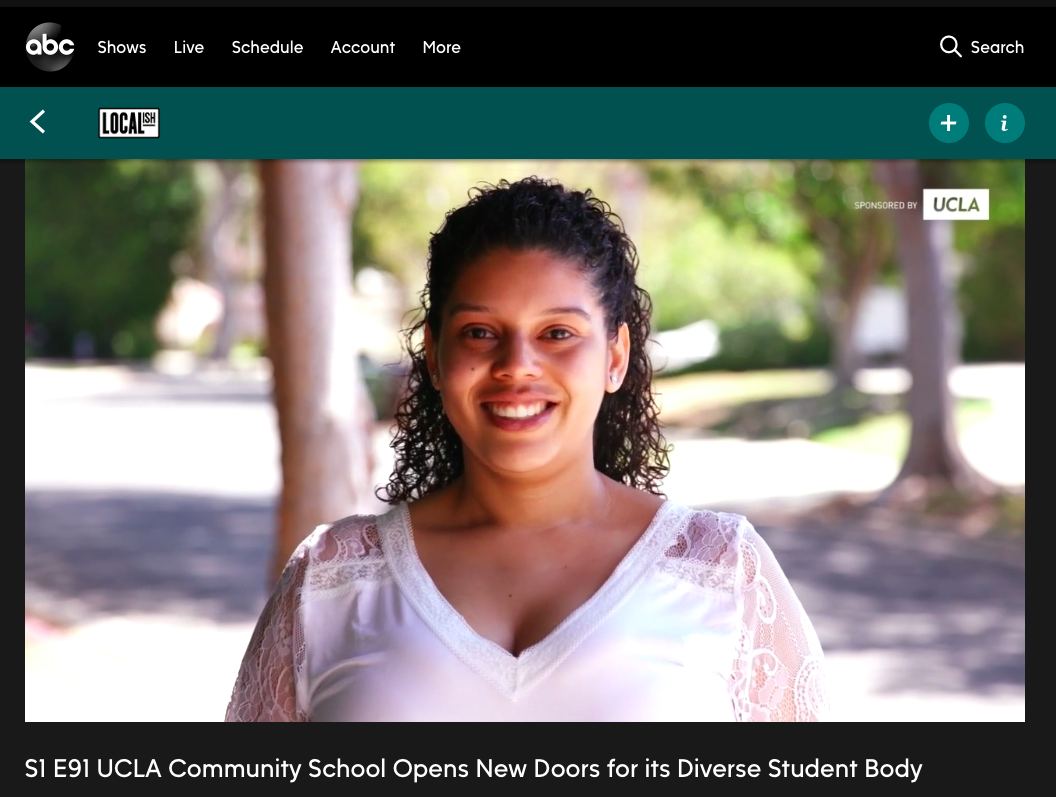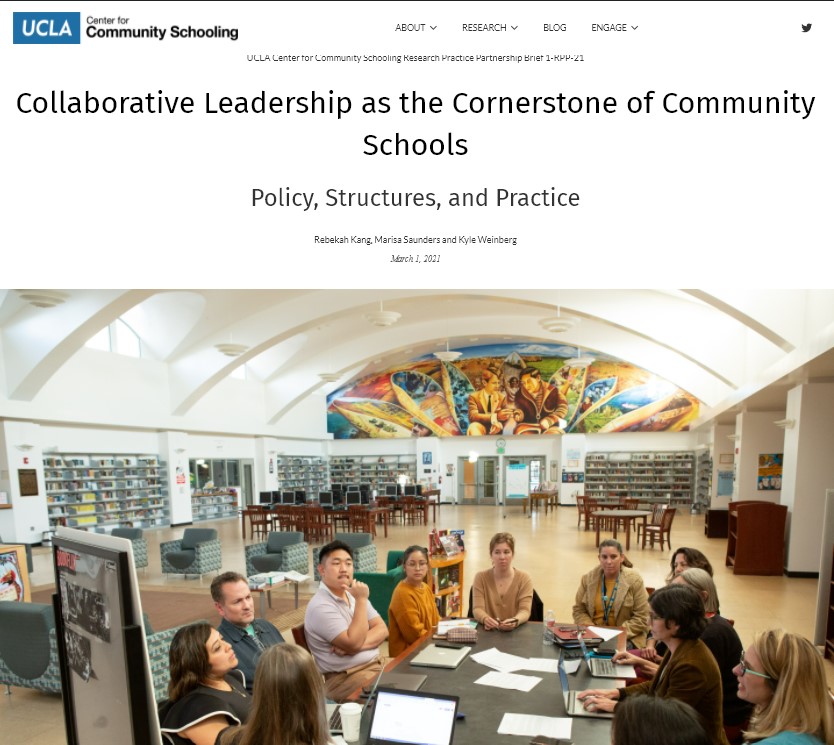UCLA Community School
Language, Sanctuary & Justice
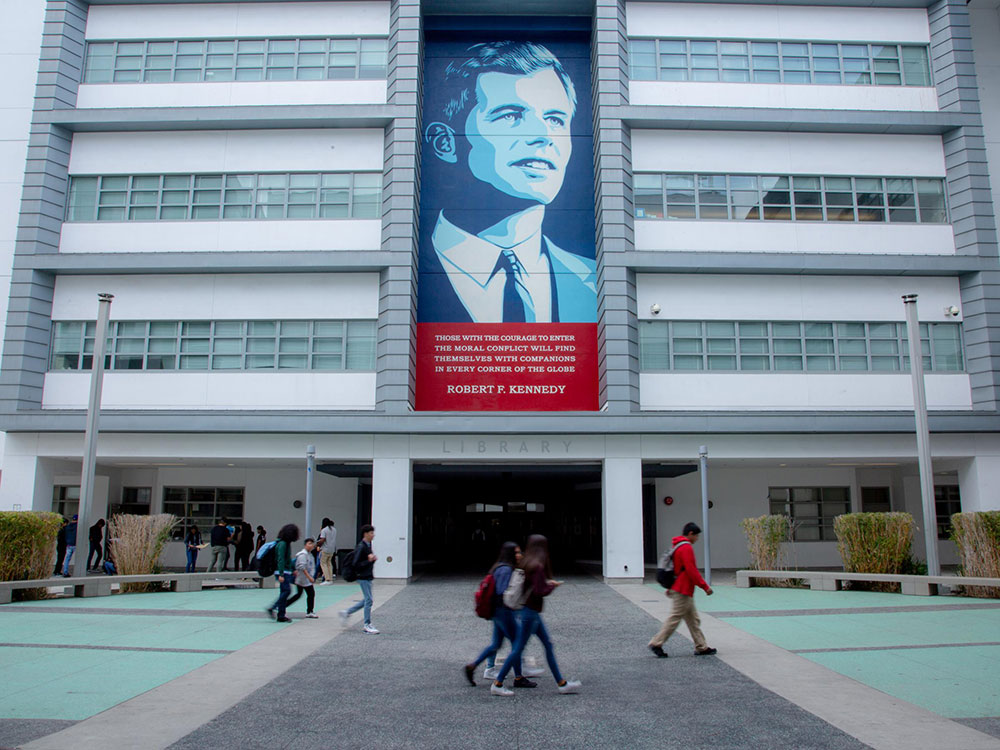
Place & People
Pico Boulevard and Union Avenue anchor one of the city’s oldest neighborhoods, part of the 1781 El Pueblo de Los Angeles. Today, Pico Union is a thriving port-of-entry community for immigrants from Central America, Mexico, Korea, and many other countries. Leyda Garcia grew up in the heart of Pico Union after immigrating from Guatemala as a middle schooler. As a student at Belmont High School—a longstanding site of struggle for educational equity—Leyda found a mentor who propelled her to college and into the teaching profession with a passion to educate immigrant-origin youth. Thirty years later, she met Queena Kim, whose family immigrated from South Korea. A resident and active member of the Koreatown community, Queena is tri-lingual in Spanish, Korean, and English, and her passion is multilingualism. Today, these two women lead the UCLA Community School, which serves 1,000 TK-12 students from Pico Union and Koreatown.
Before the school opened in 2009, students as young as five endured long bus rides to more than 65 schools across the city. The schools in their community were critically overcrowded [1], operating on year-round schedules, and less than a third of students went onto college. From the groundwork to create the UCLA Community School in 2006 to the achievement of preparing 95% of its graduates for college in 2014, this school’s success lies deep inside the people who have shaped it, the histories they have lived, and the shared beliefs that propel them forward.
This school’s success lies deep inside the people who have shaped it, the histories they have lived, and the shared beliefs that propel them forward.“
The people of the UCLA Community School, like Leyda and Queena, are diverse and rich in cultural assets and knowledge. Most students (84%) are Latino/a/x, 7% are Asian American or Pacific Islander, 5% are Filipino, 3% are African American, and 2% are White. Almost all (95%) of students report using a language other than English with their families. In addition, families experience the challenges of poverty, with 95% of the students receiving free and reduced lunch. Most of the faculty are bilingual teachers of color and they collaborate regularly with UCLA partners who serve as student teachers, teaching artists, tutors, community lawyers, researchers, and more.
The UCLA Community School was created to advance teaching, research, and service—merging the mission of the university with the core work of K–12 schooling as a university-assisted community school. It is an example of a public cross-sector partnership that contributes resources to K–12 schooling to study and support innovative educational practices that disrupt historic inequities in underserved communities of color. These resources, however, in no way eclipse the challenges the school faces. In most respects, the UCLA Community School is a very typical public school, barraged by external reforms, inadequate funding, and large class sizes. Despite these challenges, the school’s faculty, staff and partners remain committed to working within the public education system—exercising their collective agency to make change.
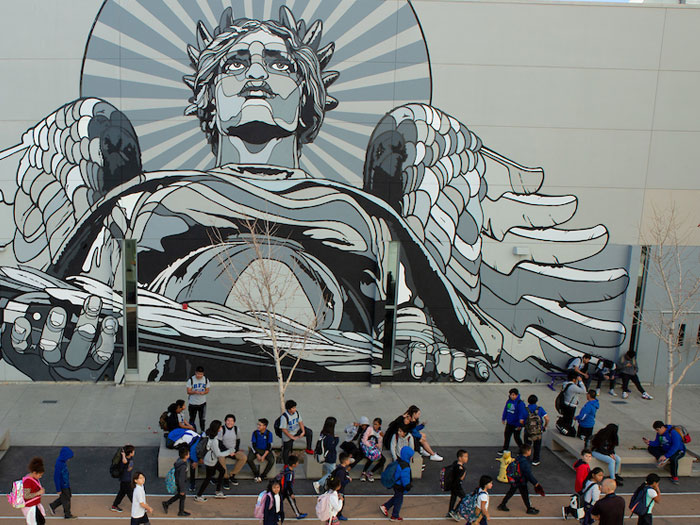
History & Vision
Housed on the former site of the Ambassador Hotel and one of six schools on the Robert F. Kennedy Community Schools campus, the UCLA Community School carries out the social justice legacy of the late Robert F. Kennedy. Kennedy’s long-standing friendship with Cesar Chavez, Dolores Huerta, and other civil rights leaders is memorialized in the school’s library—the former Embassy Ballroom–in a public art mural by Judith Baca entitled “Seeing Through Other’s Eyes.” And seeing through the community’s eyes is the approach that the school has taken to curate capacious spaces for public scholarship with a collective transformational stance that leverages the wealth of the community to nurture agency from a different baseline. Immigrant-origin youth, teachers of color, cross-disciplinary researchers, teaching artists, and many others produce knowledge that offers rich insights into how schools can transform our society.
Immigrant-origin youth, teachers of color, cross-disciplinary researchers, teaching artists, and many others produce knowledge that offers rich insights into how schools can transform our society.“
Three core beliefs guide the community’s scholarship:
- Language and culture are central to learning and human development.
- Individuals learn as members of a community that values their participation and is respectful, productive, and inclusive.
- The purpose of schooling is to guide all learners, both students and adults, to think critically about the world around them, to engage as agents of social change, and to promote democratic practices.
Staying true to these beliefs takes an ongoing commitment to each other and to collective inquiry, especially when district and state mandates undermine the school’s ability to live these three beliefs. Teachers report high levels of trust and mutual respect and it’s this culture that makes critical dialogue about ideas, beliefs and theories possible. To capture the intellectual and practical work of schooling, we offer three stories of how the school’s core beliefs came to life and continue to evolve. Following these stories, we detail how the school supports public scholarship through sustained inquiry and collective action.
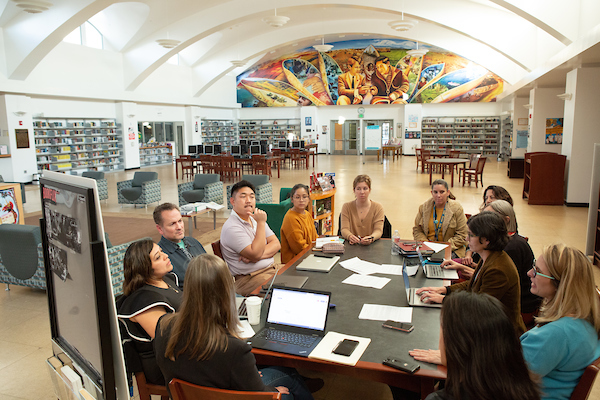
Public Scholarship
Language
Parents filtered into the multipurpose room on October 8, 2009, the school’s first “back-to-school” night, curious to learn more about the new school they had entrusted to teach their children. The lead teachers had been preparing for months, working with UCLA researchers to design a dual-language program that would honor the community’s dominant home languages of Spanish and Korean. Brochures were printed, with the bold claim that the school would prepare all children to graduate bilingual, biliterate, and multicultural. Parents were asked to waive their right to monolingual instruction, given California’s “English Only” Proposition 227, and embrace the school’s program to build on and maintain students’ home language. Students entered the school with years of experience in programs designed to erase their home languages. In this context, the notion of implementing a “proven” program model struck everyone as naïve. The problem-solving challenge went beyond instructional strategies and bilingual materials because teachers had to first know and respect what each and every child was bringing to their classrooms.
In opposition, teachers made a deliberate choice to institute a balanced biliteracy approach to language arts.“

The first few years were a big transition for both students and teachers. The No Child Left Behind reform context in 2009 prescribed a scripted phonics basal reading program to increase test scores. In opposition, teachers made a deliberate choice to institute a balanced biliteracy approach to language arts. They were developing this approach while still laying the foundation of a new school and training the staff. Many aspects of the bilingual program needed articulation and development and the program lacked cohesion and resources. Despite these challenges, staff stayed true to their beliefs. Early on teachers partnered with UCLA researchers to collect bilteracy data that countered the narrative of students as “Limited English Proficient” and generated new knowledge about students’ linguistic assets.
Lower School teachers used the data to improve their practice, trying out new read aloud, writing and other instructional strategies to improve biliteracy. Taking data use a step further, teachers collaborated with UCLA graduate student Janet Cerda to get the reading data into the hands of students. In 2016, they designed the Reader Identity Self Assessment (RISA) to help students analyze their own data and set goals to share with their parents in student-led conferences. Over time, the proportion of students’ attaining dual proficiency in Spanish and English increased and biliteracy data use and inquiry was established as a core routine of practice.
Over time, the proportion of students’ attaining dual proficiency in Spanish and English increased and the analysis of biliteracy data was established as a core routine of practice.“
As this self-assessment system expanded across grade levels, there were rich conversations about how self-regulation, identity, and language developed at different grade-levels. In 2019, the Multilingual Interdisciplinary Social Action (MISA) project and self-assessment was piloted in the Upper School, including a developmental progression to capture what a graduating, multilingual student, who is an active and critical participant in our society, should be able to do by the time they leave the school. Teachers also experimented with new translanguaging strategies in core content classes–allowing students to draw flexibly on their full linguistic repertoires to participate actively in their classrooms.
The school’s dynamic multilingual program continues to grow and evolve based on thoughtful scholarship and action. With the passage of the California Multilingual Education Act in 2016, the school no longer has to secure waivers to teach in more than one language and it is now a beacon for the broader bilingual education community. In 2021, 53% of the graduating class earned the State Seal of Biliteracy–in contrast to 13% statewide. Students embrace their multilingual identity and know that their language and culture are powerful assets that will help them navigate their futures.
In 2021, 53% of the graduating class earned the State Seal of Biliteracy–in contrast to 13% statewide. Students embrace their multilingual identity and know that their language and culture are powerful assets that will help them navigate their futures.“
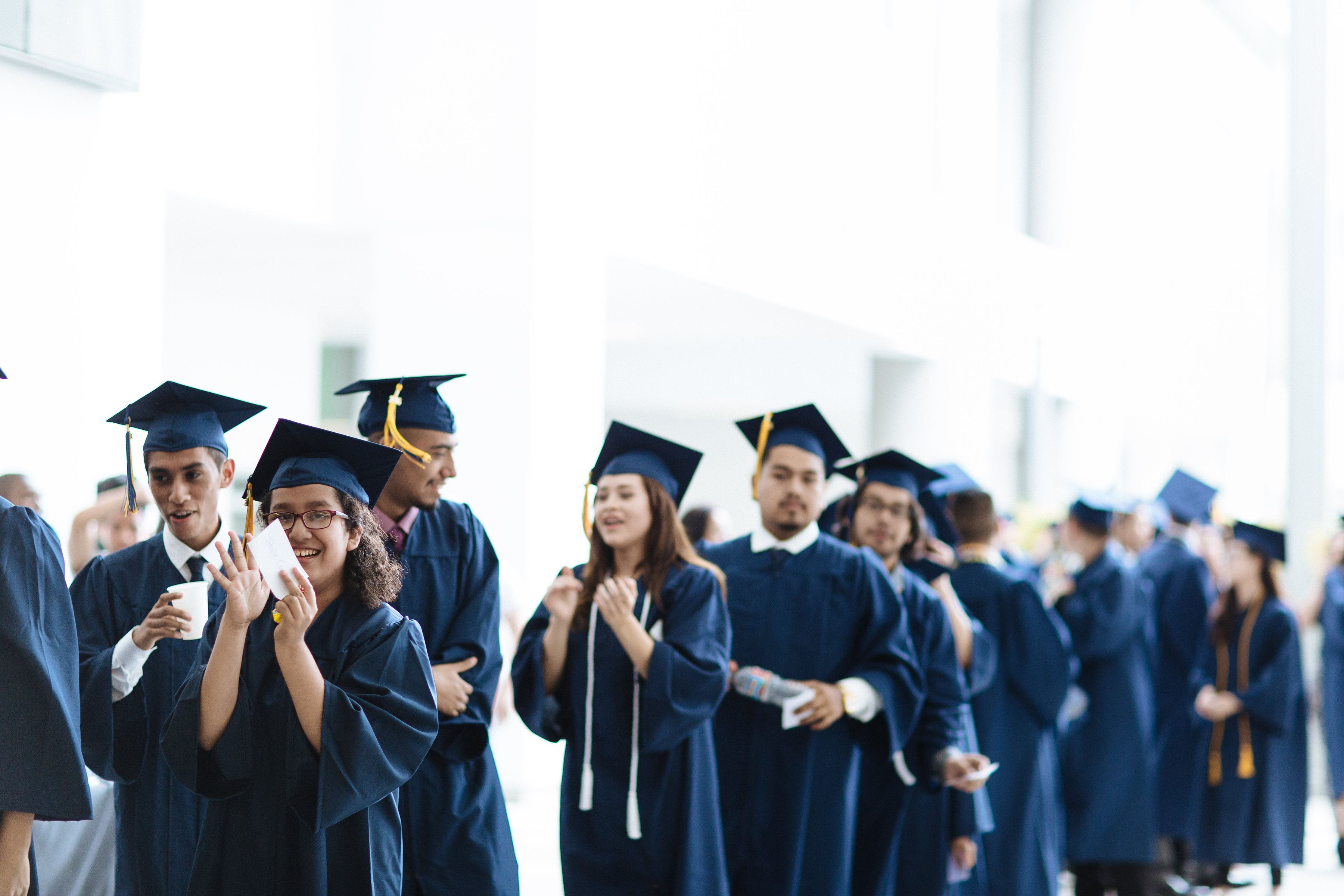
Sanctuary
In 2017, a journalist visiting the school called the campus “an oasis of multiculturalism.” Yet the oasis metaphor masks a deeper layer of meaning symbolized in the 26 murals that decorate the school–solidarity in the face of long standing oppression. A three-story mural of a high school student is overlaid with poetry: “I see you. I am you. We are one.” A student shares that she feels at home at the school: “None of us fit in the U.S. When we get together we belong.” Every teacher knows that students don’t learn unless they feel safe. The problem to solve was how to create this sense of safety in a school community where a third of the students don’t have immigration papers and constantly shifting federal legislation creates a shroud of collective fear and anxiety. [2]
A three-story mural of a high school student is overlaid with poetry: “I see you. I am you. We are one.” A student shares that she feels at home at the school: “None of us fit in the U.S. When we get together we belong.“
Over time, the school has developed a robust, multifaceted conception of sanctuary within the context of a school district, city, and state that have also claimed sanctuary status. Along with keeping federal Immigration and Customs Enforcement (ICE) agents off the school’s campus, sanctuary means creating trusting relationships and a strong sense of belonging where immigrant youth and families feel a sense of both safety and agency. The school engages in ongoing public scholarship to create institutional structures, policies, and practices designed to integrate immigrants as co-equal partners in the school community and beyond–creating what immigration scholars call a nested context of reception. [3]
Sanctuary means creating trusting relationships and a strong sense of belonging where immigrant youth and families feel a sense of both safety and agency.“
Immigrant rights organizations were at the table when the school was designed in 2007 and continue to help guide learning and development. High school seniors enroll in an Applied Economics course that places them in internships across the city, including CARECEN, KIWA, and CHIRLA, where they learn firsthand about the work of social transformation. For example, as documented in a study of the program [4], an intern at a Latina/o/x LGBTQ rights organization, used their bilingualism to create a database of Spanish language resources–scholarship the student’s mentor cited as having a “huge impact” given the dearth of bilingual resources.
In 2015, a dissertation study on the challenges undocumented students face in their journey to college also had a big impact on the school community. The school’s college center learned how to directly support undocumented students through the college application and choice process–as captured in a brief co-authored by a UCLA researcher and the college counselor. Faculty in the UCLA Law School also read the findings, informing an effort to create an Immigrant Family Legal Clinic at the school. The clinic opened in 2019, building on a 10-year history of public scholarship that continues to strengthen the community.
A sanctuary quilt, created after the 2016 election by parents and students from the Multigenerational After-school Arts (MASA) Program, hangs on the wall inside the clinic. Inspired by this vision, UCLA law students learn and work alongside immigration attorneys to provide consultations, community workshops, and direct representation for students and families across the six RFK Community Schools. To date, the clinic has served hundreds of community members through community outreach events, one-time consultations, and direct representation. The primary focus of the clinic’s services is immigration, but it also provides resources and support to immigrant families on a broad range of legal topics including workers’ rights, housing, and access to public benefits. Research on the clinic’s integration into the school community documents the range and value of these services, but also the challenge of building trust within a community that has experienced fear and intimidation when navigating the legal system. The clinic’s responsiveness during the COVID pandemic has helped build trust, as has a growing track record of successful cases for asylum and special visas available to immigrant youth, DACA renewals, work authorizations, and other efforts to support community safety and agency.
The legal clinic’s responsiveness during the COVID pandemic has helped build trust, as has a growing track record of successful asylum cases, DACA renewals, work authorizations, and other efforts to support community safety and agency.“
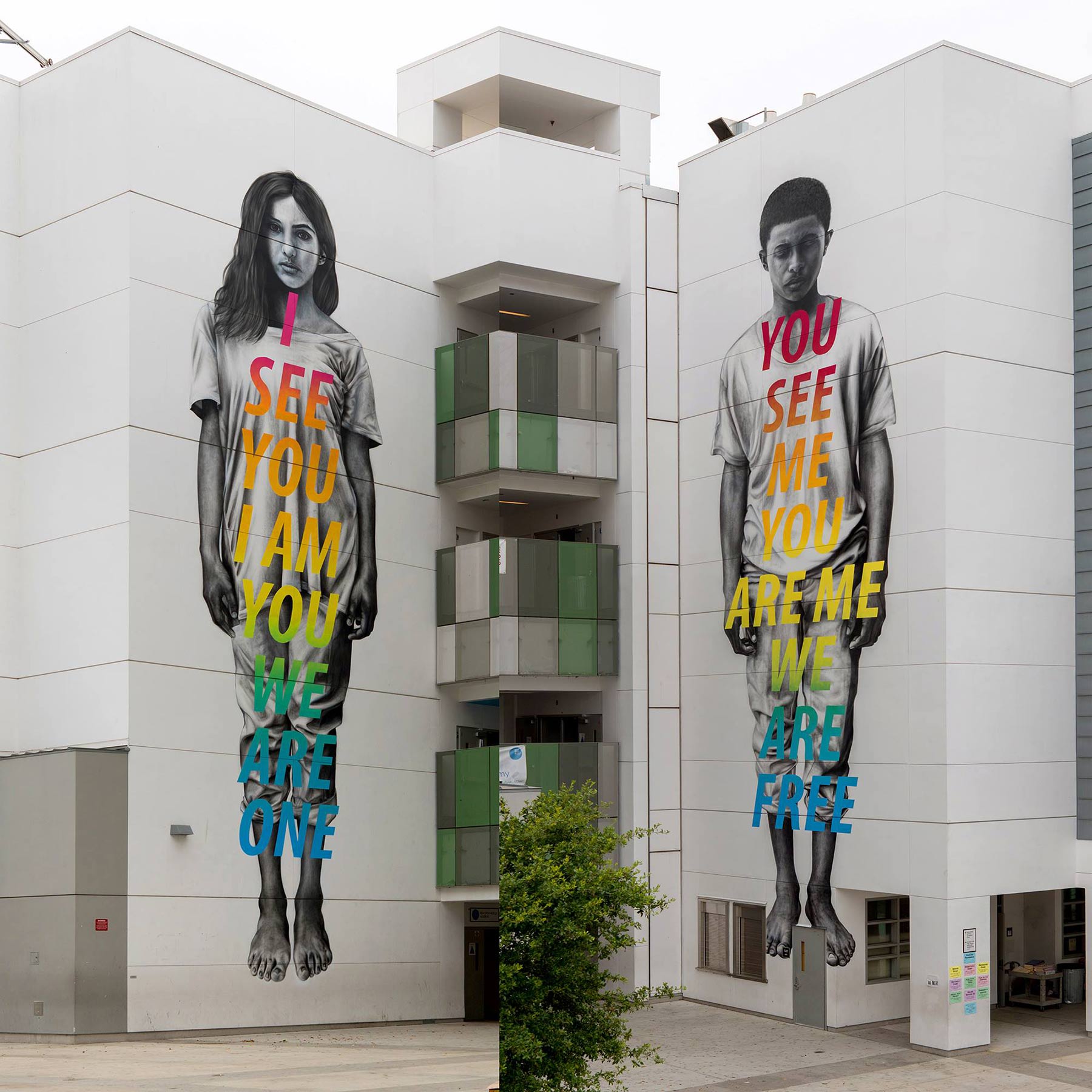
Justice
On March 5, 2018, the children and grandchildren of César Chavez and Robert F. Kennedy joined students, parents, and teachers in the school’s Cocoanut Grove auditorium. They had all come together to commemorate the fiftieth anniversary of Chavez’s historic twenty-five-day fast in Delano. The event is memorialized in the school’s library mural of Kennedy sharing a piece of bread with Chavez, honoring the solidarity of the United Farm Workers (UFW) and other struggles for civil rights. Between the two men in the mural stands UFW cofounder Dolores Huerta, who stood by Kennedy at the podium in the Embassy Ballroom, now the school’s library, on June 5, 1968, the night he was assassinated. On that spring day in 2018, to a packed and hushed audience, Ms. Huerta shared her experience working with both Chavez and Kennedy for the rights of farm workers and for social justice. She ended with a chant that felt suspended in time. Repeat after me, “Sí Se Puede!”
The school’s social justice legacy has grounded countless discussions and debates about what it means to advance justice through education.“
This social justice legacy has grounded countless discussions and debates about what it means to advance justice through education. Teachers created a social justice checklist to guide instruction. Most recently, the global pandemic and racial justice uprisings have challenged the school to think deeply about anti-racism and adopt healing-centered practices. High school students have produced art and reflection on the meaning of justice, as part of UCLA Arts’ 10 Question Series. Marlen, a high school student, reflects: “no matter your sexuality, gender, skin color, ethnicity, religion, etc, we should all be treated as equals.” On this view, advancing justice involves embracing cultural identity and difference–social justice as recognition, rooted in the cultural politics of difference and respect for persons as free and equal human beings. This conception has created an infrastructure for student agency. Elementary students express their identity and agency through artwork, play-based learning, and many other activities. Older students explore their passions in seminars and clubs, design their own research projects, and are encouraged to share what they know; as one student commented, “Teachers are very interested in learning from us.” UCLA undergraduates participate too, teaching the concept of artivism to students through portraits of social justice leaders.
Advancing justice involves embracing cultural identity and difference–social justice as recognition, rooted in the cultural politics of difference and respect for persons as free and equal human beings.“
The school is also committed to distributive justice–taking up the enormous challenge to disrupt economic, political, and social inequality by brokering access to college–a social good that has been traditionally denied to low-income students of color. A longstanding research-practice partnership has documented how the school frames, supports, and tracks college-going. Students complete annual surveys and have participated in interviews as alumni, including Victoria Amador who co-authored a report on the supports students need to persist through college. This research found that 97% of graduates leave the school with a college plan, 82% enroll the fall after graduation, 80% persist from year one to year two, but only 31% complete college in 6 years. These higher than average (for similar students) rates are cause for both celebration and concern, particularly for institutions of higher education.
The school is also committed to distributive justice–taking up the enormous challenge to disrupt economic, political, and social inequality by brokering access to college.“
To inform the University of California’s effort to help first-generation college students complete college, the school participates in a study group with four other UC-partnered public schools and is currently studying how to better support the psycho-social dimensions of college life. The school also celebrates its growing cohort of college graduates, such as Joselyne Franco who is currently enrolled in a Masters of Public Health program at UCLA. As Joselyne shares, “I’m proud to say I’m first generation, coming to college, being low-income, but I made it. The American Dream is always this phrase that gets thrown around, but, I am the American Dream.”
95% of teachers agree that it’s important to read and discuss research and 70% agree that their professional identity includes being an educational researcher.“
Supporting Public Scholarship
The UCLA Community School is part of the larger movement for community control through the Los Angeles Network of Pilot Schools–a local autonomy agreement between the community, district, and teachers’ union. As a site of public scholarship, the school engages diverse voices in studying complex topics and generating insights and actions that improve the community. When surveyed about their professional identities, 95% of teachers agree that it’s important to read and discuss research and 70% agree that their professional identity includes being an educational researcher. Many also serve as mentor teachers for the UCLA Teacher Education Program and other professional organizations. Teachers take the school’s social justice vision to heart and many participate in community organizing and other networks outside of school. For example, Rosa Jimenez co-founded Reclaim Our Schools LA and serves on the district’s community school steering committee. Rebekah Kang leads the LA Network of Teacher Powered Schools. And Jesenia Chavez writes poetry and produces a podcast: ¿Qué Me Cuentas?: Latinx Storytelling. Teachers bring their whole selves to school and to their scholarship–whole person education.
Teachers bring their whole selves to school and to their scholarship–whole person education.“
Research-practice partnerships are supported by a research subcommittee of the School Governing Council. In the summer, teachers are invited to propose R&D projects that help the school learn and grow. UCLA researchers work closely with school staff and students to produce a variety of artifacts to ensure scholarship informs their practice and helps them share what they do with the community. As a collaborative learning community, the school has also designed a variety of spaces where members of the school community come together to discuss ideas, analyze data, share stories, and solve problems–all powerful forms of public scholarship.
At this pivotal moment in the fight to preserve public schooling, the UCLA Community School is part of a larger movement to create locally responsive, whole child and whole community education. It’s a movement that lifts up the intellectual as well as practical work of teaching, celebrating the transformative power of education and the immense contributions of educators. It’s also a movement with deep democratic roots that values the ideas, cultural wealth, and engagement of each and every community member–offering a hopeful vision of what is possible when people in communities like Pico Union come together to make their world a better place.
Notes
[1] Oakes, J. (2002). Concept 6 and Busing to Relieve Overcrowding: Structural Inequality in California Schools. UCLA: ‘s Institute for Democracy, Education, and Access. Retrieved from https://escholarship.org/uc/item/30q9d8xn
[2] Ee, J., & Gándara, P. (2020). The Impact of Immigration Enforcement on the Nation’s Schools. American Educational Research Journal, 57(2), 840–871. https://doi.org/10.3102/0002831219862998
[3] Golash-Boza, T., & Valdez, Z. (2018). Nested Contexts of Reception: Undocumented Students at the University of California, Central. Sociological Perspectives, 61(4), 535–552. https://doi.org/10.1177/0731121417743728
[4] Murillo, M.A., Quartz, K.H., Del Razo, J. (2017). High school internships: Utilizing a community cultural wealth framework to support career preparation and college-going among low-income, students of color. Journal of Education for Students Placed at Risk. https://doi.org/10.1080/10824669.2017.1350182
[5] Quartz, K.H., Garcia, L., Kim, Q. & Saunders, M. (2021). Collective agency at the UCLA Community School. In Francois, A. & Quartz, K.H. (Eds.) (forthcoming). Preparing and sustaining social justice educators in urban schools. Cambridge: Harvard Education Press.
[6] Quartz, K.H., Murillo, M. & Rabin, N. (2021). Sanctuary schooling: The norms, structures, and practices that support immigrant students. In Gandara P. & Ee, J. (Eds.) Schools caught in the crossfire: The impact of immigration enforcement policies on the nation’s schools. Cambridge: Harvard Education Press.
About the Author
Karen Hunter Quartz directs the UCLA Center for Community Schooling and led the design team in 2007 to create the UCLA Community School. She also served on the design team, in 2016, to establish the Mann UCLA Community School. Karen’s research, teaching and service support community school development, teacher autonomy and retention, and democratic educational reform.
10 MINUTE READ
This case introduces you to a particular community school journey, which is intended to help you think about your own journey to create, develop, or support community schools. There are resources in the sidebar to dig deeper on particular topics and a discussion protocol designed to be used in a faculty meeting or professional development workshop. If you use these resources and have any feedback that might strengthen future school cases, please let us know.
TABLE OF CONTENTS
REPORT LINKS
RESOURCES
To explore the school’s history and experience further, check out these videos, reports, lesson plans, magazine articles, and more. These resources are curated to speak to different audiences, including teachers, researchers, policymakers, and the general public.
CITATION
Quartz, K.H. (2021). UCLA Community School: Language, Sanctuary & Justice. Community Schooling, Issue 1, Fall 2021.
ACKNOWLEDGEMENTS
Many people contributed to this case, most notably Leyda Garcia, Marisa Saunders, and Queena Kim. The story about the school’s language program is adapted from a chapter the four of us co-authored [5]. The school’s approach to sanctuary schooling is also adapted from a book chapter, co-authored with Nina Rabin, Marco Murillo and Leyda Garcia [6]. The hyperlinks throughout honor the contributions of public scholars who have worked at the UCLA Community School, including Raymundo Baltazar, Janet Cerda, Janelle Franco, Nancy Garcia, Rosa Jimenez, Kevin Kane, Rebekah Kang, Claire Keating, Ung-Sang Lee, Robert Ly, Anthony Matti, Gabrielle Perez, Karla Rivera-Torres, and Beth Trinchero, among others. I am also grateful to the Stuart Foundation for their generous support of engaged scholarship at the UCLA Community School.
REVIEWERS
This report benefited from the insights and expertise of external reviewers. Thank you to Roberta Furger, Senior Writer and Director of Storytelling at the Learning Policy Institute for her insightful comments and edits. Tracy Manuel and Christina Preston, research associates from the University of California, Davis, also reviewed the case and I thank them for their helpful feedback.

